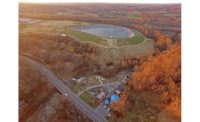Catawba Raw Water Reservoir Expansion Project
Lancaster, S.C.
BEST PROJECT
Owner: Catawba River Water Supply Project
Contractor: Phillips & Jordan Inc.
Lead Design Firm: Black & Veatch
Located adjacent to the Catawba River Treatment Plant, this $35-million project includes a 100-ft-high earthen embankment dam, a 1-billion-gallon reservoir as well as a 66-million-gallon-per-day raw water reservoir pump station that substantially expands reserves for a system serving more than 200,000 customers. Because the treatment plant relied on variable river flows for its raw water supply, backup capacity previously had been limited to no more than five days, a major concern in an area increasingly vulnerable to drought.
The embankment itself is composed of 750,000 cu yd of excavated and imported material stratified in five distinct zones, all of which had to be kept completely separate during concurrent placement work. Four separate crews worked together to meticulously manage materials and prevent cross-zone contamination, which could have compromised structural integrity.
Incorporating two 85-ft-tall chimney drains within the embankment required 8-in. to 12-in. lifts that performed simultaneously with placement of other material types. To help ensure acceptable lines and grades, the project team modified GPS-enabled excavators by attaching boxes built to the drain’s dimensions. The material for the drains was fed through the box as the excavator traced the path, allowing crews to efficiently build the drains without contaminating surrounding soils.
Crews also integrated approximately 41,000 cu yd of blanket drains with riprap armoring on the embankment’s upstream face. Contractors also constructed a reinforced concrete emergency spillway.
With much of the work taking place during the summer months, the team implemented a comprehensive heat exposure and hydration program that combined classroom training with shade, hydration and structured breaks. Heat protection was also factored into construction schedules, with concrete pours performed during overnight hours.
Worker safety also took precedence for installing a steep run of pipe. Instead of using stacked trench boxes, which would have presented access issues, the team widened the trench to eliminate the need for boxes and shields. Though more time-consuming, this approach significantly lowered risks to workers. No OSHA recordable incidents or lost-time injuries occurred during the construction phase’s nearly 150,000 staff hours.
Summer also brought interruptions from hurricanes Michael and Florence. Drawing on its disaster experience, the contractor mitigated the storm’s flooding impacts and limited project downtime. Close coordination with the treatment plant staff ensured that crews completed all reservoir improvements with no interruption to daily functions.
Back to "Southeast's Best Projects Shine With Stellar Results"







